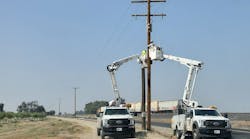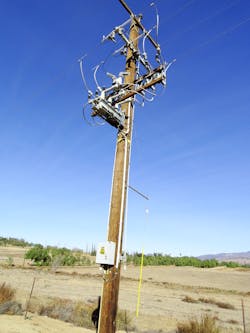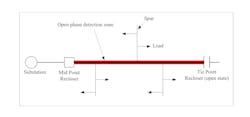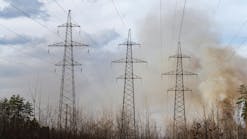Overcurrent protection is a common practice for the detection of faults on the distribution system, including downed wire. It is an appropriate and industry accepted methodology for system protection; however, in certain downed conductor scenarios, risks associated from shock and ignitions may still exist due to the variation in fault impedance.
If the fault impedance is high enough, the fault may not be detectable by typical overcurrent relays, due to very small current flow to ground. Even when over-current protection operates properly, arcing to vegetation may result in an ignition particularly during dry and windy conditions which can elevate fire risks.
As part of SCE’s wildfire mitigation efforts, SCE began exploring methods to detect open phase conditions to de-energize overhead distribution electric systems before a conductor hits the ground to help further reduce risks associated with electrical shocks and fire ignition. There is a short time duration of around a second from the time a conductor separates to the moment it reaches earth.
Current measurement based open phase detection schemes are being applied on SCE’s transmission system; however, voltage-based schemes are needed for distribution systems due to the complexity of load connections.
SCE developed a plan using existing devices equipped with three-phase voltage measurement capability to detect open phase conditions, which may be able to operate protective devices before conductors touch the ground. Additionally, model simulations proved critical in improving the logic to differentiate open phase conditions from fault events, increasing security of the system to avoid potential reliability impacts.
SCE recently completed installation of various rapid earth fault current limiter (REFCL) systems which also have the capability to detect some open circuit conditions in addition to the wildfire mitigation benefit they offer by limiting ground fault energy. At the same time, SCE continues to review how this detection scheme may function with other grid hardening technologies such as covered conductor.
Detecting Open Phases
Although several novel approaches to detect open phase conditions using phasor measurement units (PMU) have been proposed, SCE sought a solution that could be applied with existing field devices and began by studying the symmetrical voltage components, positive sequence (V1), negative sequence (V2), and zero sequence (V0), produced by open-phase and faulted conditions.In recent years, SCE deployed automatic reclosers with integral voltage sensors on all three phases. These sensors provide phase voltage measurements, which in turn provides calculations for symmetrical components.
SCE’s team envisioned using end-point voltage measurements as a potentially viable solution to allow for open phase detection with minimal data transfer that has the potential to integrate with SCE’s existing low-bandwidth radio system.
In this approach, end-of-line tie point recloser controller configured to detect an open phase condition sends a small packet message or trip command to the upstream device. The logic can also be applied back to the substation device though on SCE’s system hardware updates are needed for expansion to these zones. The source device needs to be able to check that system condition is normal to prevent mis-operating for an open phase upstream and avoid a voltage disturbance cascading effect. It takes about one second for an open conductor to reach the ground level from a height of 30 feet.
To achieve the voltage measurements required for symmetrical voltage calculations, which are required for the open phase detection (OPD) scheme, the method uses either potential transformers (PT) or electronic voltage sensors connected in a wye (star) configuration. Delta connections are unable to provide zero sequence voltage, so they cannot be used.
An initial study focused on detecting an open circuit for a purely three-wire system as a large portion of SCE’s overhead distribution circuitry is three-wire with no neutral extending from the substation. After the study, SCE formed a plan taking the calculated results into consideration and piloted it on a few distribution circuits. This method saw a series of misoperations where ground faults were detected as open phases.
At this point, it remained unclear how to validate the logic and define boundary conditions for the voltage settings to discriminate open phase events from traditional fault conditions. SCE’s distribution system is a complex network of power lines with multiple transformer and load types. The distribution circuit will respond differently to loading conditions and system disturbances. A disturbance on a circuit would be affected by the system conditions prevailing at that moment.
SCE applied computer simulations to better understand the symmetrical voltages imposed on a distribution circuit for different system disturbances, including one-phase open versus two-phases open conditions. This makes system variations observable under both normal and abnormal operating conditions through an actual electric system modelled and simulated onto a computer platform.
To understand the behavior of a distribution main-line circuit in abnormal state, a detailed analysis was performed on a 12kV distribution system model. The model ran over 5,000 fault and open phase(s) simulations at multiple points throughout the circuit for collecting the voltage response at the tie device.
The data analysis indicated that for a conductor that breaks between the substation and the monitoring device downstream, its voltage collapses whereas the voltage on the non-broken conductors stays at nominal level. The results of the simulations also show that the way the load transformers are connected affect the system voltages. For a four-wire load that includes a neutral, the voltage of the broken wire falls close to zero. But when the load has three-wire only, with no neutral, the drop in voltage on the broken conductor is about half of the nominal phase to neutral voltage due to the backfeed through the transformer windings into the open phase.
When two conductors break, their respective voltages measured at the tie point are reduced compared to the unbroken phase, which still carries its system voltage. This is where the transformer wiring influences the results most clearly. Voltage collapses to near zero on the two open phases when the load has a neutral connection. When the load is only connected phase to phase, the phase that is still close and energized will cause voltage to backfeed and induced to the two open phases causing an equivalent voltage on all the three phases.
A one open phase and a two open phase are discernable by the measured symmetrical voltages. While an open wire dictates the outcome of the zero sequence (V0) and negative sequence (V2) voltages, in the case of two open conductors, it is the zero sequence (V0) and positive sequence voltages (V1) that are the predominant factors.
Open Phase Detection Logic
An OPD scheme allows for unique detection logic for each condition which clearly impacts a different number of conductors. This became critical for avoiding detecting of open phase conduction during a traditional fault event which often also creates a voltage collapse. The threshold values of the voltages were configured to help minimize detection of an open phase condition during a traditional fault event.
All the faults and open phase simulations values were applied to two equations developed entirely in house for a one open phase and two open phases conditions. Only the open phase conditions resulted in a true output as desired.
To date, more than thirty tie points recloser controllers on 12kV circuits have been programmed with the two-detection logic. A short timer was also added to delay the pickup on an open phase detection by a few cycles to filter out transients. Once an open condition is detected with the short timer, an alert is transmitted to the source recloser device via radio command. Since this scheme is in pilot stage, it is configured in an alarming mode with tripping disabled.
Real System Open Phase Occurrence
At least a dozen open phase alarms were generated since implementation of the logic in May 2020. One of them was issuing a constant warning over several hours. An analysis of the event report oscillography collected from the relay matched the simulated open phases. In short, it displayed all criteria satisfying an open conductor condition which justified the alarm signal. While troubleshooting between the tie and mid-point reclosers, the crew found a detached main line jumper with half a lug at its terminal and the barrel part still connected to a disconnect switch. The broken terminal connector caused the open phase. Since then, this termination is being retrofitted with higher duty rating to compensate for the strong Santa Ana winds.
Many other detections are the results of single phase switching. These demonstrate the logic is correct as they are actual open phase conditions but also are a sign of the added complexity required to implement an OPD algorithm. It will be necessary to disable the OPD algorithm whenever single-phase switching is performed and re-enabled at the conclusion of the switching.
The open phase alarms have proven the significance of the computer simulations performed to refine the OPD logic and reject conditions related to faults. With OPD evaluation installations, SCE has demonstrated the capability to detect certain open phase conditions and avoid operation while connections remain intact. SCE continues to monitor installation performance and expects to expand the detection logic for larger scale evaluation.
Acknowledgements
The authors express their sincere appreciation to Bryan Pham, Thuan Tran, Joshua Park, Christopher Peck, Kirk Heintz and Craig Moody for the huge support in accomplishing this project.
Jesse Rorabaugh, P.E., is a senior engineer at Southern California Edison (SCE). He received his bachelor’s degree at California State University, Fresno with a triple major in physics, chemistry and biology followed by a master’s degree in biomedical engineering from Cornell University and a professional engineer license as an electrical engineer in California. He is an active IEEE member and serves as chair for the G4 working group responsible for IEEE Std 1246 Guide for Temporary Protective Grounding Systems Used in Substations and Std 1268 Guide for Safety in the Installation of Mobile Substation Equipment as well as vice chair for the G9 working group responsible for IEEE Std 837 Standard for Qualifying Permanent Connections Used in Substation Grounding.
Arianna Ojeda is an engineer at Southern California Edison (SCE) with more than two years of experience. She received her bachelor’s degree in Electrical Engineering from California State University Long Beach. Arianna is a member of IEEE and currently pursuing her master’s degree in Electrical Engineering at California State Los Angeles.
Andrew Swisher, P.E., is a consulting engineer at SCE. He received his bachelor’s degree from California State Polytechnic University at Pomona in electrical and computer engineering with a certification in power engineering followed by a master’s degree from the University of Idaho, Moscow with a certification in power system protection and relaying. Swisher is a licensed professional engineer registered as an electrical engineer in California.
Vahe Bolbolian, P.E., is a senior engineer at Southern California Edison (SCE). He received his bachelor’s degree in Electrical Engineering from California State Polytechnic University at Pomona, Master’s degree in Electrical Engineering from The University of Idaho, and is a licensed professional engineer registered as an electrical engineer in California.
Reshma Ramdoss, P.E., is an engineer at Southern California Edison (SCE). She received her bachelor’s degree in Electrical and Electronic Engineering from the University of Mauritius followed by a master’s degree in electrical and computer engineering from GeorgiaTech. Reshma is a member of the Institution of Engineering and Technology (IET), UK, and a licensed professional engineer registered as an electrical engineer in California.
Brendan Kirkpatrick, P.E., is an engineering manager in the Asset Engineering department at Southern California Edison (SCE). He earned a bachelor’s degree in Electrical Engineering, summa cum laude, with an emphasis in Digital Signal Processing from California State University, Long Beach. He is licensed as a Professional Electrical Engineer in the state of California, and is an active member of the IEEE Power & Energy Society Switchgear Committee.





